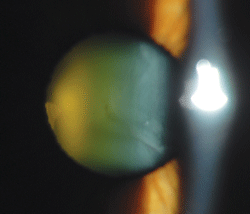Statin use significantly decreases an individual’s risk of cataract development, according to research presented at the European Society of Cardiology Congress in Amsterdam, Netherlands.

The longer patients use statins, the less likelihood of cataracts.
In a meta-analysis of 13 clinical trials, John B. Kostis, MD, professor at the Robert Wood Johnson Medical School in New Brunswick, NJ, and associates investigated the incidence of cataract development in nearly 2.4 million patients on statin therapy. The mean age of the total study population was 61 years.
The researchers concluded that patients who remained on statin therapy for an average of 54 months were approximately 20% less likely to develop cataracts than those with no history of statin use.
Further, the research indicated that the longer patients remained on statin therapy, the less likely they were to develop cataracts. More specifically, patients who received statin treatment for six months exhibited a 10% risk reduction for cataractogenesis, whereas those who used statins for 14 years experienced a 55% risk reduction.
Interestingly, the overall incidence of cataractogenesis varied dramatically depending upon patient age. “Our analysis shows that people in their 40s who use statins have a 50% lower chance of getting cataracts. For people in their 70s, risk is lowered by just 10%,” Dr. Kostis said. So, “it is possible that the two processes [aging and statins] work in parallel or interactively.”
This research shows statins are not only safe, but useful against cataracts. “There is persistent concern among physicians and other health care providers about the possible cataractogenicity of statins,” said Dr. Kostis. However, “our findings dispel worries about the safety of statins when it comes to cataracts, and lends additional support to long-term statin use.”
Kostis JB, Dobrzynski JM. Statins prevent cataracts: a meta-analysis. Presented at the European Society of Cardiology Congress 2013. August 31-September 4; Amsterdam, Netherlands.

